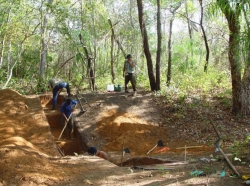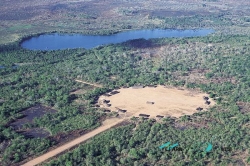Kuhikugu is an archaeological site located in Brazil, at the headwaters of the Xingu River, in the Amazon Rainforest. The area around Kuhikugu is located in part of the Xingu National Park today. Kuhikugu was first uncovered by anthropologist Michael Heckenberger, working alongside the local Kuikuro people, who are the likely descendants of the original inhabitants of Kuhikugu.
The archaeological site of Kuhikugu proved to be a large urban complex that may have housed up to 50,000 inhabitants, inhabited by indigenous ancestors of the current cuicuros from about 1 500 to four hundred years ago. Probably built by the ancestors of the current cuicurus peoples, the site houses complex constructions such as roads, fortifications and trenches for protection. To feed the large population, there were cultivated fields and orchards in the city. Perhaps the most incredible discovery is that of dams for raising fish. As the discovery is recent, studies on the life forms of these populations are still needed, although scholars believe that these people cultivated cassava.
The disappearance of this civilization, as well as other great Amazonian civilizations, is related to the entry of diseases such as smallpox and mumps on the American continent, responsible for decimating indigenous Amerindian populations, around the 16th century. The natural characteristics of the Amazon Forest (dense forest, etc.) would explain why the colonists did not come into contact with this Amazonian civilization.
The complex occupied a total area of 20 thousand km². Lake Lamakuka provided the village with fish, which were the main source of protein in the Kuikuro diet.
But they not only fished: they practiced fish farming, choosing species and encouraging their reproduction. This is a habit still practiced today by several indigenous groups.
The indigenous population was not concentrated in a large agglomeration, like the Aztecs and Incas, but in multiple interconnected villages, which formed a political entity. The largest, probably the capital, had 5,000 inhabitants. It was surrounded by wooden palisades to avoid enemy attacks.
The archaeological site of Kuhikugu proved to be a large urban complex that may have housed up to 50,000 inhabitants, inhabited by indigenous ancestors of the current cuicuros from about 1 500 to four hundred years ago. Probably built by the ancestors of the current cuicurus peoples, the site houses complex constructions such as roads, fortifications and trenches for protection. To feed the large population, there were cultivated fields and orchards in the city. Perhaps the most incredible discovery is that of dams for raising fish. As the discovery is recent, studies on the life forms of these populations are still needed, although scholars believe that these people cultivated cassava.
The disappearance of this civilization, as well as other great Amazonian civilizations, is related to the entry of diseases such as smallpox and mumps on the American continent, responsible for decimating indigenous Amerindian populations, around the 16th century. The natural characteristics of the Amazon Forest (dense forest, etc.) would explain why the colonists did not come into contact with this Amazonian civilization.
The complex occupied a total area of 20 thousand km². Lake Lamakuka provided the village with fish, which were the main source of protein in the Kuikuro diet.
But they not only fished: they practiced fish farming, choosing species and encouraging their reproduction. This is a habit still practiced today by several indigenous groups.
The indigenous population was not concentrated in a large agglomeration, like the Aztecs and Incas, but in multiple interconnected villages, which formed a political entity. The largest, probably the capital, had 5,000 inhabitants. It was surrounded by wooden palisades to avoid enemy attacks.




